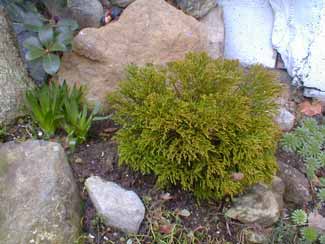
'James Stirling'
Ashwin Whipcord Hebe
Hebe ochracea is native to New England grasslands & thickets. The select cultivar 'James Stirling' (often mispelled Sterling) is a recipient of Royal Hulticultural Society's Award of Garden Merit.
The species has in the past been regarded as a natural hybrid, or confused with H. armstrongii, but is presently accepted as its own species. It's native to mountains of western Nelson, on the South Island, New Zealand.
I would have assumed this select strain was named for Sir James Stirling the Scottish explorer who established the first free colony in Australia, & for whom Stirling Gardens in the City of Perth is named. But the Hebe Society says it was named after the Superintendent of Government Gardens in Wellington, New Zealand.
A dwarf golden-hewed olive-green evergreen, this whipcord hebe becomes bronzy-gold in winter, & is a deeper green the rest of the year. The teency bright white flowers in spring or summer may not occur until the shrub is several years old, but it will be of extreme interest even without flowering.
The photo shows the Whipcord Hebe at the beginning of February, still with a winter glow. To its left is a bulbous Scilla peruviana which produced a short patch of grass in autumn, but is still some while away from bloom. Above the Whipcord at the point of the rockery is a young Indian Hawthorn which will someday be quite a big overhanging presence. To the right of the hebe are some Hen & Chicks succulents.
Teency white flowers occur at the branch tips in summer, but these have never been many nor showy on ours, so it is appealing chiefly for its remarkable foliage. Whipcord hebes almost resemble dwarf false cypress or juniper or similar conifer, but really is a hebe, but with scale-like leaves along the branches. The branches arch into a compact vase-shape to a foot of height. It is capable of reaching two feet of height & equal or greater spread, but growth is very slow & ours have remained a foot tall for years. As a substitute for dwarf juniper it's a step upward in real elegance.
It likes full sun, though ours does fine with partial sun. It is not fussy as to soil conditions & does well as a container plant. It is drought-hardy within limits. An especially hot dry summer we learned the hard way can be a killer. We originally had two of these little shrubs in this miniature rockery, but in their third year the one planted mere inches higher upon the rockery dried out & died very suddenly during a heat wave. The other one was just enough lower to retain a tad more soil moisture during those record-hot days, so was unphased by the heat.